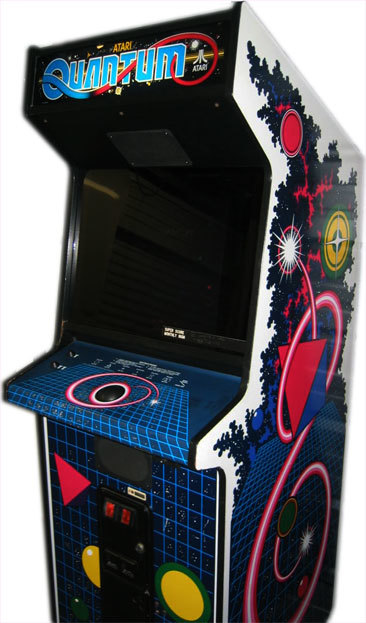Quantum was a color vector arcade game brought out by Atari Inc. in 1982. The game was developed in Cambridge, Massachusetts, by General Computer Corporation.
The cache is not at the posted coordinates but is within one mile. Park in the lot behind the corporation with the same name as the game (no relation).

Quantum was developed under the code name Molybdenum Molecular Magic. Early versions of the cabinet had both a quarter and a nickel slot, though inflation got the best of the latter.
The premise of the game was related loosely to quantum physics in that the player directed a probe with a trackball to completely circle atomic particles from palladium crystals for points, without touching various other particles. Once the particles were surrounded by the probes' tail they were destroyed.
Entering one's initials for the game's high score table was unique compared to all other games of the era; the player would use the trackball to circle the letters of his or her initials in the same fashion that was used to circle the particles during gameplay. If the player achieved the highest score on the table, the initials screen was preceded by another in which the player would use the trackball to actually draw his or her initials in an entry box. Some players were adept enough with the trackball to actually write their names legibly in the box, replacing the “Betty” that was there in honor of the head programmer, Betty Tylko.

The Particles:
• Electrons: 20 points - Rotated slowly around the nucleus.
• Nuclei: 300 points - Moved slowly around, bouncing off walls. Would clip the probe's tail if it crossed it. Capturing all the nuclei on the screen advanced play to the next level.
• Photons: 200 points - Entered from one edge of the screen, span across the screen, and disappeared off the other side.
• Pulsar: 400 points - Travelled towards the probe, pulsing its "arms" in and out as it moved.
• Positrons: 200 points - Formed by stray electrons left when a nucleus exploded. Moved from its point of origin to the edge of the screen very quickly.
• Splitters: 100 points - Travelled in a random pattern across the screen, flashed colors and split into 3 after a few seconds, each of these 3 splitting again after a few more seconds.
• Triphons: 100 points - Moved around the screen randomly.
The game was one of the very first to use the 68000 microprocessor. Early versions of the hardware ran quite hot, inspiring a constant running joke, “Art (Art Ng, head hardware designer), will we need to cool this with liquid nitrogen?” to which he would always reply, “It’s running well today; Liquid nitrogen? Na, we’re fine.”
Another interesting piece of trivia was that the engineers had to deal with excessive wear on the copper bearings in the trackball mechanism. Just before production, the bearings were switched to military-grade titanium, which may have been overkill, but it did solve the problem.
Today Quantum is highly sought after and is considered one of the holy grails of classic arcade coin-op collecting.


This cache is part of RetiredGuy's Classic Video Game Series of caches:
